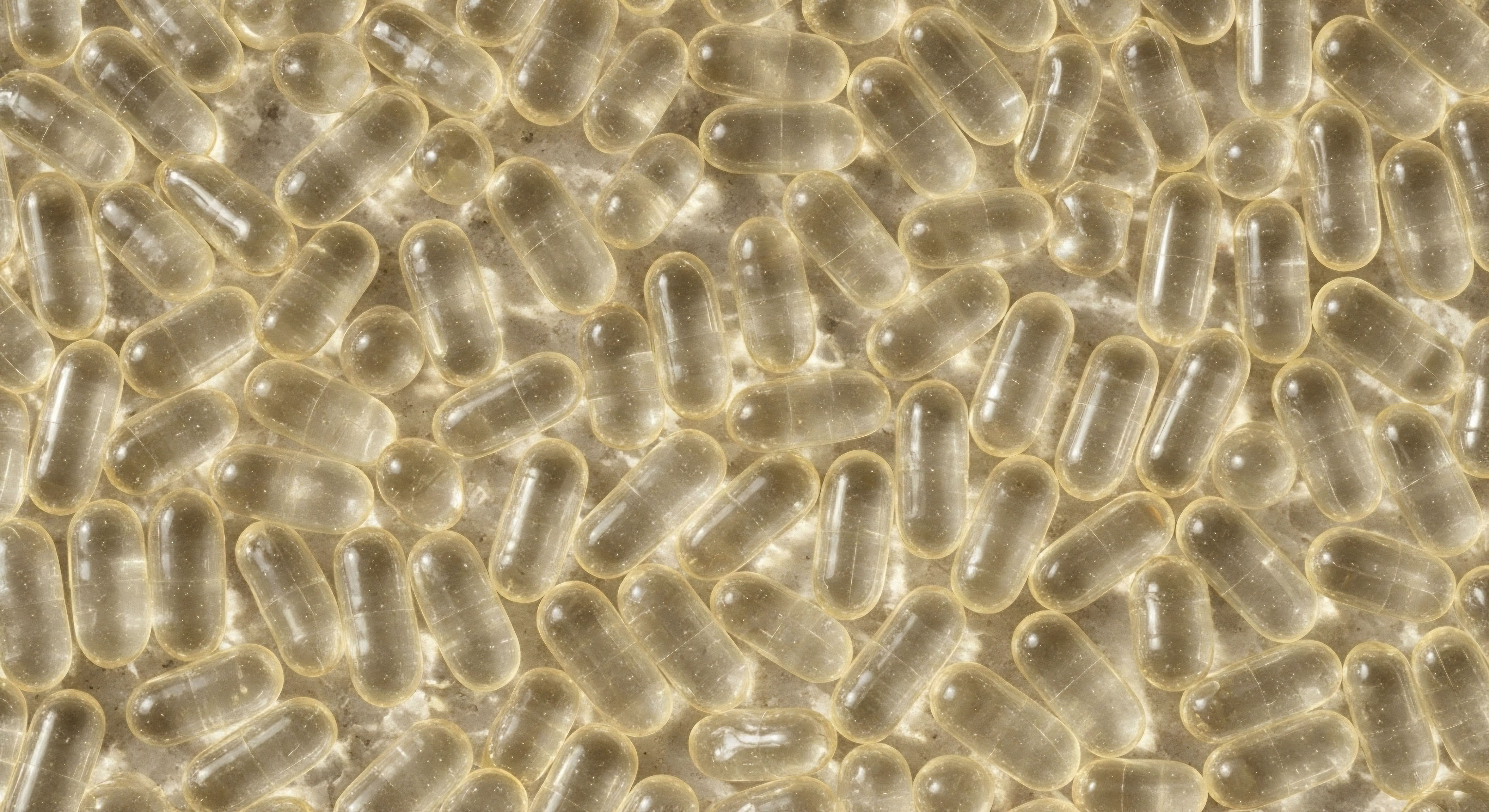

Fundamentals
The feeling is unmistakable. It is a form of exhaustion that settles deep into your bones, a mental fog that resists caffeine, or a subtle shift in your body’s composition that seems disconnected from your efforts in the gym and kitchen. These experiences are data points.
They are your body’s method of communicating a change within its intricate internal messaging service, the endocrine system. This network of glands and the hormones they produce governs everything from your energy levels and mood to your metabolism and reproductive health. Understanding that your symptoms are signals, not failings, is the first step toward reclaiming your biological sovereignty.
The question of whether lifestyle adjustments can truly alter this complex internal environment is a critical one. The answer is an unequivocal yes. Your daily choices are powerful inputs that directly inform hormonal production and signaling. The food you consume, the way you move your body, the quality of your sleep, and your management of stress are not passive activities.
These are active conversations with your endocrine system, capable of steering it toward balance or pushing it toward dysfunction. This process works because hormones do not operate in isolation; they exist in a state of dynamic equilibrium, governed by sophisticated feedback loops. By modifying the inputs, you can systematically change the output, creating a cascade of positive effects throughout your entire physiology.

The Core Pillars of Hormonal Influence
To comprehend how lifestyle recalibrates hormonal health, we must first appreciate the primary levers at our disposal. These four pillars represent the most consistent and impactful ways you interact with your endocrine system daily. Each one provides a distinct set of instructions to your body’s master regulators.

Nutritional Biochemistry the Building Blocks of Balance
Every meal is a packet of information for your cells. The macronutrients ∞ protein, fat, and carbohydrates ∞ and micronutrients ∞ vitamins and minerals ∞ you ingest are the literal raw materials for hormone synthesis. For instance, steroid hormones like testosterone and estrogen are derived from cholesterol, a type of fat.
Without adequate intake of healthy fats, your body simply lacks the necessary substrates to produce these vital molecules. Similarly, amino acids from protein are essential for creating peptide hormones, such as insulin and growth hormone. Nutrients like zinc and vitamin D are indispensable cofactors in the enzymatic reactions that build hormones. A diet deficient in these key nutrients is akin to asking a factory to produce goods without providing the raw materials.
Your diet provides the foundational chemical components from which your entire hormonal symphony is composed.

Movement as a Metabolic Signal
Physical activity is a potent hormonal stimulus. Different forms of exercise send distinct signals that elicit specific endocrine responses. Resistance training, for example, creates mechanical stress on muscle fibers. This stress signals the body to release anabolic hormones like testosterone and growth hormone (GH) to repair and rebuild the tissue stronger than before.
This is a primary mechanism for maintaining muscle mass and metabolic health. Aerobic exercise, conversely, is exceptional at improving insulin sensitivity, meaning your cells become more efficient at utilizing glucose from the bloodstream. This reduces the burden on the pancreas and helps stabilize energy levels. The key is understanding that exercise is a form of controlled stress that, when followed by adequate recovery, strengthens the entire system.

Sleep the Master Endocrine Regulator
The period of nightly rest is when the endocrine system performs its most critical maintenance and recalibration. During the deep stages of sleep, the pituitary gland releases pulses of growth hormone, which is vital for tissue repair and cellular regeneration.
Simultaneously, the production of the stress hormone cortisol reaches its lowest point, allowing the body to enter a state of recovery. Sleep deprivation disrupts this delicate choreography. It suppresses GH release, elevates cortisol levels into the evening, and dysregulates the appetite hormones leptin (which signals satiety) and ghrelin (which signals hunger). This is why poor sleep can lead to sugar cravings, metabolic dysfunction, and persistent fatigue; the body’s core hormonal rhythms have been thrown into disarray.

Stress and the Adrenal Axis
Your body’s stress response system, the Hypothalamic-Pituitary-Adrenal (HPA) axis, is designed for acute, short-term threats. In modern life, chronic psychological, emotional, and physiological stressors keep this system in a state of constant activation. The result is a perpetual elevation of cortisol.
Chronically high cortisol can suppress the function of other vital hormonal systems. It can interfere with thyroid hormone conversion, leading to symptoms of low metabolism. It can also suppress the Hypothalamic-Pituitary-Gonadal (HPG) axis, which governs reproductive health and the production of testosterone and estrogen. Learning to manage stress through practices like mindfulness, deep breathing, or simply spending time in nature helps to down-regulate the HPA axis, creating the physiological space for other hormonal systems to function optimally.
These pillars are not separate disciplines. They are deeply interconnected. A nutrient-poor diet can worsen sleep quality, which in turn elevates stress hormones, which then drives cravings for more nutrient-poor food. Conversely, improving one area creates momentum for the others. Regular exercise can improve sleep quality and stress resilience.
A whole-foods diet stabilizes blood sugar, reducing physiological stress on the body. This integrated approach is the foundation upon which lasting hormonal balance is built, demonstrating that you have profound agency over your own internal chemistry.


Intermediate
Acknowledging that lifestyle choices influence hormones is the first step. The next is to understand the precise biological mechanisms through which these choices exert their power. This requires moving beyond general principles to examine the specific molecular conversations happening inside your body.
When you eat, move, or sleep, you are providing direct feedback to complex regulatory networks that govern your health. Significant alteration of your hormonal balance is achievable when these inputs are applied with intention and consistency, directly targeting the pathways of hormone synthesis, transport, and signaling.

How Can Diet Systematically Recalibrate Hormonal Pathways?
The food on your plate is a primary driver of your endocrine profile, influencing everything from moment-to-moment energy regulation to long-term reproductive health. The composition of your diet provides the building blocks and the operational instructions for your hormonal systems.

Macronutrients as Hormonal Precursors and Signals
Your intake of fats, proteins, and carbohydrates has direct and predictable effects on your endocrine system. Dietary fats are particularly important for steroid hormone production. Cholesterol is the parent molecule from which testosterone, estrogens, progesterone, and cortisol are synthesized. Diets that are excessively low in fat can compromise the body’s ability to produce these hormones.
The type of fat also matters. Polyunsaturated fats, especially omega-3 fatty acids, help form healthy cell membranes, which improves the sensitivity of hormone receptors. This means the hormones you do produce can communicate more effectively with their target cells.
Carbohydrates, particularly their quality and timing, are the primary regulators of insulin. Consuming refined carbohydrates and sugars leads to rapid spikes in blood glucose, prompting a large release of insulin to shuttle that sugar into cells. Chronically high insulin levels can lead to insulin resistance, a condition where cells become “numb” to insulin’s signal.
This state is a major driver of metabolic disease and can cause downstream hormonal chaos, including elevated androgens in women (a key feature of PCOS) and inflammation that disrupts other endocrine pathways. Opting for complex, fiber-rich carbohydrates slows glucose absorption, promoting a more stable insulin response.
A diet rich in whole foods provides both the raw materials for hormone synthesis and the metabolic stability required for clear signaling.

The Gut Microbiome and the Estrobolome
A fascinating area of research reveals a profound connection between gut health and hormonal balance, particularly concerning estrogen. Your gut contains a collection of bacteria known as the estrobolome, which produces an enzyme called beta-glucuronidase. This enzyme plays a crucial role in estrogen metabolism.
After the liver processes estrogens for excretion, they are sent to the gut. The estrobolome can “reactivate” some of this estrogen, allowing it to re-enter circulation. A healthy, diverse gut microbiome maintains a balanced level of beta-glucuronidase activity, ensuring proper estrogen clearance.
However, gut dysbiosis ∞ an imbalance of gut bacteria often caused by a poor diet, stress, or antibiotics ∞ can alter this process. An overgrowth of certain bacteria can lead to excess beta-glucuronidase activity, causing too much estrogen to be reabsorbed. This can contribute to conditions of estrogen dominance, highlighting the gut as a critical control point for hormonal health.
| Dietary Approach | Key Principles | Primary Hormonal Impact |
|---|---|---|
| Western Diet | High in processed foods, refined sugars, unhealthy fats; low in fiber. | Promotes insulin resistance, elevates cortisol, can disrupt estrobolome function leading to estrogen imbalance. |
| Mediterranean Diet | Rich in whole foods, vegetables, fruits, legumes, healthy fats (olive oil, nuts), and lean protein (fish). | Improves insulin sensitivity, provides precursors for steroid hormones, supports a healthy gut microbiome, and may help balance testosterone levels. |
| Low-Carbohydrate / Ketogenic Diet | Very low carbohydrate intake, high fat intake, moderate protein. | Dramatically lowers insulin levels, can increase testosterone in some populations, but long-term effects on thyroid and adrenal health require careful monitoring. |

Movement the Science of Hormetic Stress
Exercise is a form of hormesis ∞ a beneficial stressor that stimulates adaptations that make the body stronger and more resilient. The key is to apply the right dose of stress and allow for adequate recovery.
- Resistance Training ∞ Lifting heavy weights creates microscopic tears in muscle fibers. The response to this stimulus is a coordinated release of testosterone, growth hormone (GH), and Insulin-like Growth Factor 1 (IGF-1). These hormones are the primary architects of muscle repair and growth. This adaptation improves your overall metabolic health by increasing the amount of glucose-disposing tissue you have.
- High-Intensity Interval Training (HIIT) ∞ Short bursts of all-out effort followed by brief recovery periods are a powerful stimulus for GH release. HIIT is also exceptionally effective at improving insulin sensitivity and increasing mitochondrial density, effectively upgrading your cellular engines.
- Endurance and Chronic Cardio ∞ While moderate aerobic exercise is beneficial for cardiovascular health and insulin sensitivity, excessive duration can lead to chronically elevated cortisol levels. This catabolic state can break down muscle tissue for fuel, suppress immune function, and interfere with reproductive hormones. This illustrates the importance of balancing training volume with recovery.

Sleep Architecture and Hormonal Cascades
The impact of sleep on the endocrine system is tied to its structure, known as sleep architecture. Different sleep stages trigger different hormonal events.
Slow-wave sleep (SWS), or deep sleep, is dominant in the first half of the night. It is during SWS that the pituitary gland releases its largest pulses of growth hormone, essential for physical repair. Any factor that fragments deep sleep, such as alcohol consumption or sleep apnea, will blunt this critical regenerative process.
The second half of the night is characterized by more REM sleep and a gradual rise in cortisol, which helps you wake up with energy and alertness. Sleep deprivation disrupts this entire rhythm. It leads to lower GH and testosterone levels, while causing cortisol to be elevated in the evening when it should be low.
This creates a state of being “tired and wired,” and directly impairs glucose metabolism, with some studies showing that just one week of sleep restriction can induce a pre-diabetic state in healthy individuals.
| Sleep State | Primary Hormonal Event | Effect of Disruption |
|---|---|---|
| Slow-Wave Sleep (Deep Sleep) | Peak release of Growth Hormone (GH). | Impaired tissue repair, muscle loss, accelerated aging. |
| Full Night’s Sleep Cycle | Suppression of evening cortisol; regulation of leptin and ghrelin. | Elevated evening cortisol, increased hunger and appetite, insulin resistance. |
| Waking | Morning cortisol peak (Cortisol Awakening Response). | Blunted cortisol awakening response, leading to daytime fatigue and low motivation. |
These interconnected systems demonstrate that hormonal balance is not a static destination. It is a dynamic process that reflects the sum of your daily inputs. By making conscious, evidence-based adjustments to your nutrition, movement, and sleep, you are engaging in a form of biological negotiation, guiding your endocrine system back toward its innate state of health and optimal function.


Academic
An academic exploration of lifestyle’s influence on hormonal balance requires a shift in perspective from individual hormones to the integrated neuroendocrine axes that govern them. The most elegant example of this is the Hypothalamic-Pituitary-Gonadal (HPG) axis, the master regulatory system for reproductive and metabolic health in both men and women.
The functionality of this axis is exquisitely sensitive to environmental and physiological inputs. Therefore, lifestyle modifications do not merely nudge hormone levels; they fundamentally alter the central command signals that dictate gonadal steroidogenesis. The significant alteration of hormonal balance is possible precisely because lifestyle factors directly modulate the pulsatility of Gonadotropin-Releasing Hormone (GnRH), the apex regulator of the entire HPG cascade.

The GnRH Pulse Generator a System of Exquisite Sensitivity
The entire HPG axis is driven by the pulsatile secretion of GnRH from specialized neurons in the hypothalamus. This is not a continuous stream but a rhythmic, metronomic signal. The frequency and amplitude of these GnRH pulses determine the subsequent release of Luteinizing Hormone (LH) and Follicle-Stimulating Hormone (FSH) from the anterior pituitary.
LH, in turn, stimulates the Leydig cells in the testes to produce testosterone and the theca cells in the ovaries to produce androgens, which are then converted to estrogens. FSH supports spermatogenesis in men and follicular development in women. The system’s genius lies in its sensitivity. The GnRH pulse generator is not an isolated clock; it is an integration center that receives and interprets a vast array of signals from the body, including metabolic status, stress levels, and circadian rhythms.
The function of the reproductive axis is a direct reflection of the body’s perceived safety and resource availability.
This is where lifestyle’s profound influence becomes clear. The hypothalamus must answer a critical biological question before permitting robust reproductive function ∞ “Is the body in a safe and well-resourced state?” Chronic stress and energy deficits are interpreted as signals of an unsafe environment, leading to a down-regulation of the GnRH pulse generator to conserve resources. This is a primary adaptive mechanism that is, however, maladaptive in the context of modern chronic stressors.

What Are the Key Modulators of GnRH Pulsatility?
Several key afferent signaling pathways converge on GnRH neurons, and these pathways are directly influenced by lifestyle choices. Understanding these connections provides a clear, evidence-based rationale for non-pharmaceutical intervention.

Metabolic Gating via Leptin and Insulin
The hormone leptin, secreted by adipose tissue, is a primary indicator of long-term energy status. Leptin receptors are expressed on hypothalamic neurons, and sufficient leptin signaling is permissive for GnRH release. In states of significant calorie restriction or excessively low body fat, leptin levels fall, signaling energy scarcity.
This inhibits GnRH pulsatility, leading to hypothalamic amenorrhea in women and secondary hypogonadism in men. Conversely, leptin resistance, often seen in obesity, can also disrupt HPG axis function. Insulin, the primary regulator of short-term glucose metabolism, also has a modulatory role.
Healthy insulin sensitivity appears to support proper GnRH function, whereas the hyperinsulinemia characteristic of metabolic syndrome can disrupt it, contributing to conditions like PCOS where LH pulsatility is abnormally high. A diet focused on nutrient density and glycemic control directly supports the healthy leptin and insulin signaling required for optimal HPG axis function.

Inhibitory Pressure from the HPA Axis
The stress-responsive HPA axis exerts powerful inhibitory control over the HPG axis. When the HPA axis is activated, it releases Corticotropin-Releasing Hormone (CRH) and, subsequently, cortisol. Both CRH and cortisol can directly suppress GnRH secretion at the hypothalamic level. Glucocorticoids can also reduce the pituitary’s sensitivity to GnRH and directly impair gonadal function.
This makes biological sense ∞ in a “fight or flight” scenario, reproduction is a low priority. In the context of chronic modern stress, this sustained inhibitory pressure leads to a functional suppression of testosterone and estrogen production. Lifestyle interventions aimed at mitigating stress ∞ such as mindfulness, adequate sleep, and avoidance of overtraining ∞ work by reducing this chronic inhibitory tone, thereby allowing the GnRH pulse generator to resume its normal rhythm.

The Role of Inflammation
Systemic inflammation, often driven by a poor diet, gut dysbiosis, or chronic infections, is another potent suppressor of the HPG axis. Pro-inflammatory cytokines, such as Interleukin-1 (IL-1), Interleukin-6 (IL-6), and Tumor Necrosis Factor-alpha (TNF-α), have been shown to inhibit GnRH secretion.
These inflammatory molecules signal a state of systemic threat or illness, which, much like stress, prompts the body to down-regulate energy-intensive processes like reproduction. A diet high in processed foods and low in anti-inflammatory compounds (like omega-3s and polyphenols) perpetuates a state of low-grade chronic inflammation. Conversely, a whole-foods, plant-rich diet, combined with a healthy gut microbiome, reduces the inflammatory load on the body, removing another layer of suppression from the HPG axis.

A Systems Biology Conclusion
Viewing hormonal health through the lens of the HPG axis reveals that lifestyle adjustments are not merely supportive measures. They are primary interventions that target the root of hormonal regulation.
A nutrient-dense diet that ensures metabolic stability, a balanced exercise regimen that avoids chronic catabolism, restorative sleep that optimizes circadian signaling, and active stress management collectively create an internal environment that signals safety and resource abundance to the hypothalamus. This signal is the prerequisite for robust GnRH pulsatility.
In many cases of functional hormonal imbalance, the issue is not a broken gland but a suppressed central command system that is responding appropriately to adverse lifestyle inputs. By systematically improving these inputs, one can restore the permissive conditions necessary for the HPG axis to function as intended, leading to a significant and lasting restoration of hormonal balance without the need for exogenous intervention.
- Nutrient Density and Glycemic Control ∞ Directly supports the leptin and insulin signaling that gates GnRH release.
- Balanced Exercise and Recovery ∞ Prevents the chronic cortisol elevation from overtraining that suppresses the HPG axis.
- Restorative Sleep ∞ Aligns circadian rhythms, which are critical for the timing of hormonal pulses, including GnRH and GH.
- Stress Management ∞ Reduces the inhibitory pressure from CRH and cortisol on the entire reproductive axis.
Therefore, a clinical approach that prioritizes these foundational lifestyle strategies is addressing the system at its most fundamental level of control. It is a direct and powerful method of endocrine recalibration.

References
- Leproult, R. & Van Cauter, E. (2011). Effect of 1 week of sleep restriction on testosterone levels in young healthy men. JAMA, 305(21), 2173 ∞ 2174.
- Allen, N. E. Appleby, P. N. Davey, G. K. & Key, T. J. (2000). The effect of diet on plasma sex hormones in men. Nutrition Research Reviews, 13(2), 1-28.
- Whittaker, J. & Wu, K. (2021). Low-fat diets and testosterone in men ∞ Systematic review and meta-analysis of intervention studies. The Journal of Steroid Biochemistry and Molecular Biology, 210, 105878.
- Spiegel, K. Leproult, R. & Van Cauter, E. (1999). Impact of sleep debt on metabolic and endocrine function. The Lancet, 354(9188), 1435 ∞ 1439.
- Kraemer, W. J. & Ratamess, N. A. (2005). Hormonal responses and adaptations to resistance exercise and training. Sports Medicine, 35(4), 339 ∞ 361.
- Baker, F. C. Siboza, F. & Fuller, A. (2020). The role of the gut microbiome in estrogen metabolism. Menopause, 27(7), 846-849.
- Kopelman, P. G. (2000). Obesity as a medical problem. Nature, 404(6778), 635-643.
- Mullur, R. Liu, Y. Y. & Brent, G. A. (2014). Thyroid hormone regulation of metabolism. Physiological Reviews, 94(2), 355 ∞ 382.
- Hirotsu, C. Tufik, S. & Andersen, M. L. (2015). Interactions between sleep, stress, and metabolism ∞ From physiological to pathological conditions. Sleep Science, 8(3), 143 ∞ 152.
- Volek, J. S. Kraemer, W. J. Bush, J. A. Incledon, T. & Boetes, M. (1997). Testosterone and cortisol in relationship to dietary nutrients and resistance exercise. Journal of Applied Physiology, 82(1), 49-54.

Reflection
You have now traveled through the intricate biological landscapes that connect your daily actions to your internal chemistry. You have seen that the sensations you experience ∞ the fatigue, the brain fog, the shifts in your body ∞ are not random occurrences but a coherent language. The knowledge presented here is a translation guide for that language. It is designed to move you from a position of passive experience to one of active participation in your own health narrative.
The path forward is one of self-study and informed action. Your body is the ultimate laboratory, and these principles are the protocols for your experiments. What happens when you prioritize sleep with the same dedication you give to your career?
How does your body respond when you nourish it with the specific building blocks it needs to function? The answers will be unique to you. They will be written in your energy levels, your mental clarity, and your overall sense of vitality.
This information is the start of a new conversation with your body. The goal is not perfection, but consistent, compassionate attention. Listen to the signals. Respect the systems at play. The power to direct your own biology is a profound responsibility and an immense opportunity. The next chapter of your health journey is yours to write.



